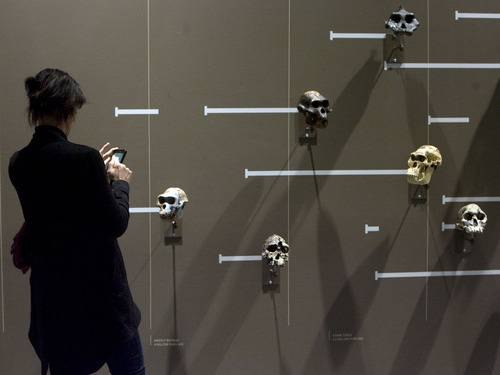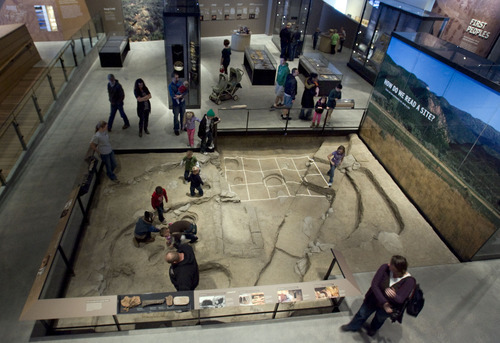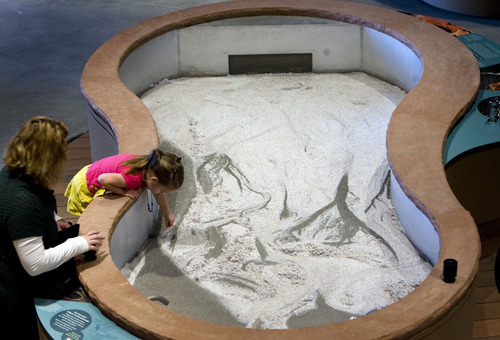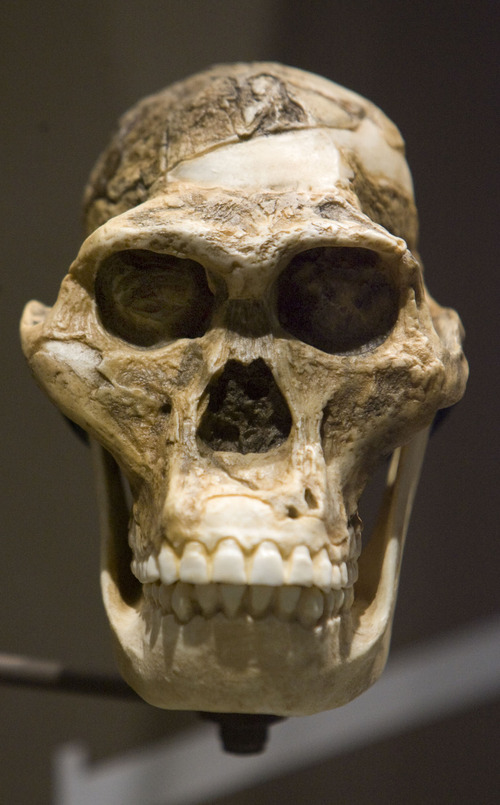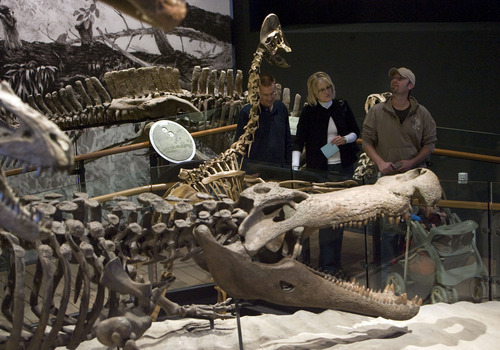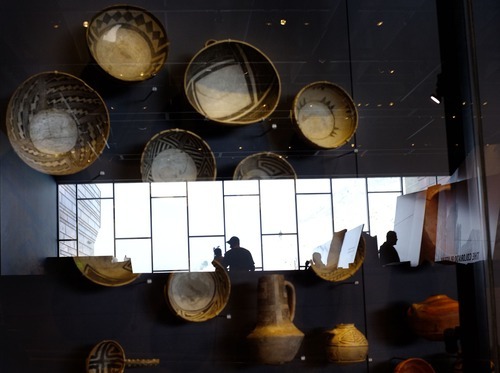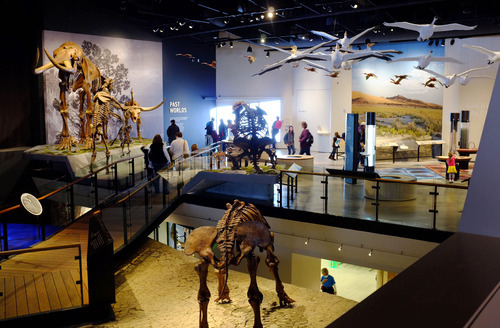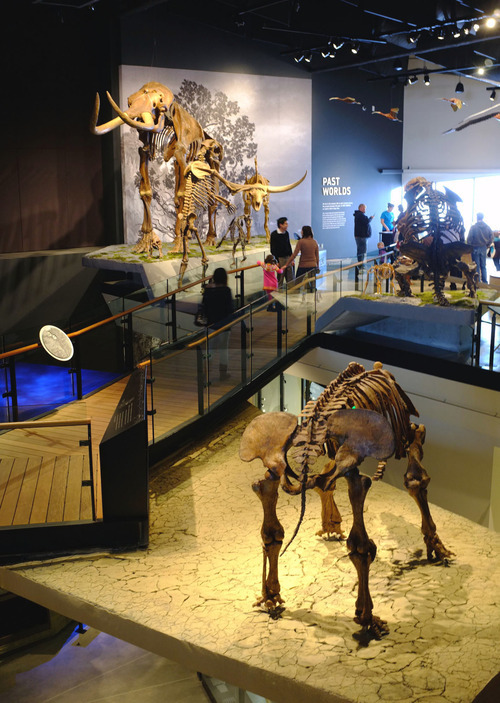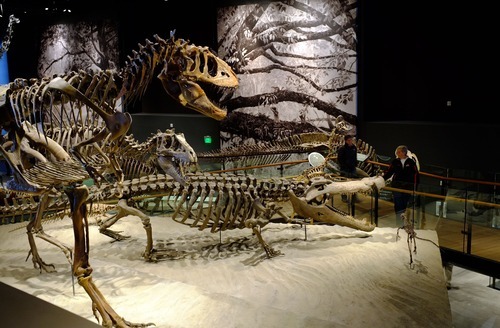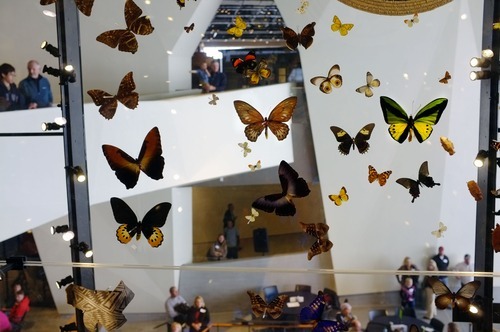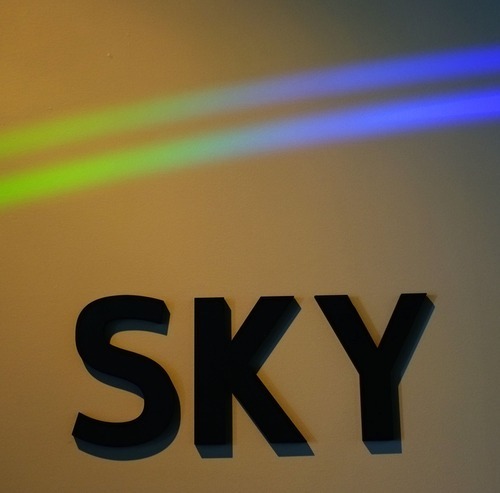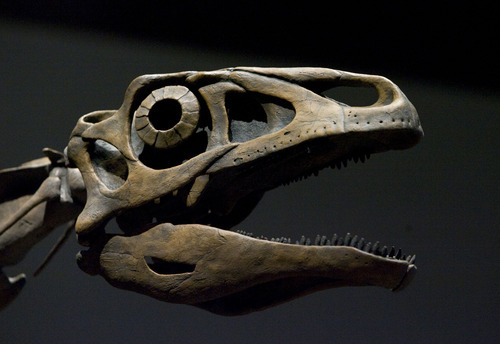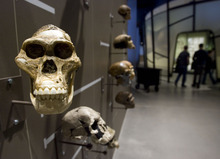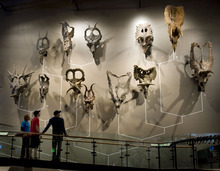This is an archived article that was published on sltrib.com in 2011, and information in the article may be outdated. It is provided only for personal research purposes and may not be reprinted.
When it comes to museums, nothing shouts "old school" louder than dioramas, those life-size replicas of natural environments inhabited by lifeless animals in lifelike poses.
But the Natural History Museum of Utah, which reopens Friday in the new Rio Tinto Center, is anything but old school. From its soaring open spaces and artful displays, to the interactive exhibits and natural environment outside its walls, this is an experience that engages all the senses, appealing to the heart as well as the head.
The dioramas are alive with the actual sounds — and even smells — of animals and landscapes. And there's a little something extra in the hot-desert diorama: Its cryptogamic soil sports a big fat boot print. Designers debated whether to depict impact of humans as they explored ideas for fresh exhibits to capture the breadth of Utah's wonders.
"The mission of the museum is to illustrate the natural world and the place of humans in it," museum Director Sarah George said. "There was a lot of discussion whether these photos and dioramas should [show] pristine nature, and we decided no, because that's not the way it is."
After a yearlong closure, the museum's 15-year quest for a new home culminates with its reopening next door to Red Butte Garden. The University of Utah gave the museum a $102-million makeover, which has produced a spectacular interactive attraction, a state-of-the-art repository for collections and a full-fledged research unit.
In the half-century since the idea of a state natural history museum was hatched, it has evolved from an academic setting where glass walls and written descriptions separated visitors from displays to something more like a playground.
The new museum has a foot in both worlds. Kid-friendly interactive stations populate most of the galleries, which also feature explanatory displays that illuminate big-scope scientific concepts like plate tectonics and genetics. Other displays are more narrowly focused: One examines mounds of ancient animal waste to reconstruct past landscapes.
"We are at a place where we know there are tremendous advantages to both [approaches]. Dioramas are an old form, but people love them," said George, a biologist specializing in small-mammal genetics who became the museum's director in 1992. "This is taking the best of these different traditions and putting them together to make a wonderful experience. The most effective learning occurs when emotion is evoked."
—
The making of a museum • Utah's official museum has come a long way since the 1950s, when the U. anthropology department stored fragile archaeological objects in a former mess hall at Fort Douglas. For four decades starting in 1969, the museum's exhibits and collections filled rooms intended for books at the Thomas Building, built in the 1930s on Presidents Circle as the main university library. The biggest threat to the collections was the building itself, which was vulnerable to earthquakes and was falling apart.
"We were having a flood every three to six months. Pipes weren't just breaking, they were disintegrating," George said.
Now for the first time, the state's cultural and natural treasures are stored and displayed in a building designed for that purpose.
The project's $102.5 million cost was covered by a wide range of sources, including a $15 million bond approved by Salt Lake County voters to pay for exhibits; $25 million from the state; $15 million in corporate money from Rio Tinto, which owns the Kennecott copper mine; and millions in various grants from federal agencies and private donations. At one point, the museum was accused of inappropriately tapping public funds to produce and distribute materials supporting the bond campaign, but the measure passed by a wide margin.
The site also proved controversial, with critics noting the irony of digging up a foothill setting for a building celebrating Utah's natural heritage.
But building the museum elsewhere would have cost significantly more and didn't guarantee the commercially-zoned land near Red Butte would be conserved, officials argued. The 17 acres south of Red Butte Garden was already owned by the university and was served by existing infrastructure. But more importantly, they hoped to create a visitor experience that allowed immediate access to nature.
"We have the opportunities to be uniquely about Utah and unique among museums of how we interpret the natural world," George said. In the meantime, the university placed conservation easements on five acres of gambel oak lining the western edge of the property on Colorow Drive. And Bonneville Shoreline Trail has reopened, running between the museum's entrance patio and its parking lot.
George's predecessor, Don Hague, had always hoped the museum would get a new home. "The new building exceeds my dreams manyfold. I'm really thrilled," he said. "This is the realization of the ultimate in care and conservation for those collections."
As a biology and art student in the 1940s and '50s, Hague worked with archaeologist Jesse Jennings at a time when cultural and natural objects were flowing onto campus.
"We used the walk-in freezers to put objects in, including human remains," Hague said. "The condition of the collections was terrible, scattered around the campus, pots inside of pots and bugs everywhere."
—
Something for everyone • The museum's towering central atrium, called the Canyon, is a unifying element in a space that both separates and connects the building's two major components: the collections and "back-of-house" labs on the north side, and the exhibits on the south. Spanning this space are two sky bridges, reminiscent of sandstone formations found in southern Utah.
As the interface between the building's halves, a glass case extending all the way from the Canyon's floor to its ceiling holds 500 objects arranged to emphasize beauty over scientific value.
"Science takes things apart and analyzes individual components. But that's not the way human beings experience the world," said architect Todd Schliemann. "The collection case exposes what's behind that wall. You can peer in and see how real science is taking place."
The Collections Wall, which portrays the range of the building's contents across time, disciplines and regions, exemplifies the museum's effort to simultaneously evoke emotion and support science, according to museum associate director Ann Hanniball. An undulating line of colorful butterflies meanders upward through dinosaur bones, a petrified stump, Ancestral Puebloan pottery and elaborately beaded native Utahn attire. The specimens appear to float because their mounts are largely invisible.
Elsewhere, young visitors are welcome to touch and play with displays. The archaeology gallery, called First Peoples, has an excavation site sunk into the floor where kids can imagine themselves on a dig, while a platform in the Land gallery invites people to erect structures of blocks and metal to see how well they hold up in an earthquake.
"A family can walk throughout the museum together, and there should be something for everyone at every stop," George said. Past Worlds, the gallery devoted to paleontology, will be a star attraction, with its massive specimens depicting key moments in the 225 million years of life in Utah.
Complete mounts feature creatures of the ancient past and near past — giant sloth and bison, a mammoth, a saber tooth cat and other animals that conceivably shared the landscape with Utah's first human inhabitants more than 10,000 years ago.
There is nothing lifeless in the way these bones are displayed. Even by contemporary museum standards, the gallery's largest exhibit is striking for its energy, depicting a life and death struggle between a 90-foot barosaurus and a pack of juvenile allosaurs. It's a perfect example of the museum's goal to be scientifically accurate while creating a sense of drama.
"We wanted to emphasize that they aren't just bone turned to rock, but living animals in living ecosystems. The best way to do this is show them in active lifelike poses," said paleontology curator Randall Irmis.
bmaffly@sltrib.com —
You should go: Natural History Museum of Utah
The Rio Tinto Center, home of the University of Utah's Natural History Museum of Utah, opens Nov. 18.
Where • North end of Colorow Drive, next to Red Butte Garden on the east side of Research Park.
Hours • 10 a.m. to 5 p.m., daily except Wednesday when it closes at 9 p.m. The cafe opens at 7:30 a.m. Monday through Saturday, and 8:30 a.m. on Sundays. Museum admission isn't required to visit the cafe.
Admission • $9 adults; $7 for seniors over 65 and visitors 13-24; $6 for children 3 to 12; and free for kids 2 and under. Admission is free on opening day, but tickets will be required for timed entry. Learn more at www.umnh.utah.edu.
Special events • The museum will have free days every three months, including Jan. 9, April 9 and July 9. Family memberships cost $95 and include benefits such as free admission, discounts in the gift shop and cafe, and free admission to 300 participating museums and science centers in the ASTC Passport Program.
Getting there • The museum has 150 parking spaces and is served by U. of U. shuttle buses, while the nearest UTA stop is a block down the hill at Chipeta Way. Visitors can also get to the museum on foot or by bicycle on the Bonneville Shoreline Trail from the north and south. Explore the new museum online
Take a visual tour of the new museum, see more photos, and watch videos of interactive exhibits. > www.sltrib.com —
Rio Tinto Center, by the numbers
Cost • $102.5 million
Size • 163,000 square feet; 51,000 square feet of exhibition space
Collection • 1.2 million objects
Copper siding • 42,000 square feet
Exhibits • 2,500 mounts


